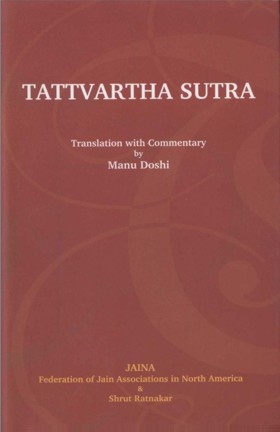07.01 Hinsānrtasteyabrahmaparigrahebhyo Viratirvratarn
Audio: Sanskrit: हिंसाऽनृतस्तेयाऽब्रह्मपरिग्रहेभ्यो विरतिर्व्रतम् ।
Hindi: हिंसा, असत्य, चोरी, मैथुन और परिग्रह से (मन, वचन, काय द्वारा) निवृत्त होना व्रत है।
07.02 Deshsarvato'numahati
Audio: Sanskrit: देशसर्वतोऽणुमहती ।
Hindi: अल्प अंश में विरति अणुव्रत और सर्वांश में विरति महाव्रत है।
07.03 Tatsthairyārtham Bhavanah Panch Panch
Audio: Sanskrit: तत्स्थैर्यार्थ भावना: पञ्च पञ्च ।
Hindi: उन (व्रतों) को स्थिर करने के लिए प्रत्येक व्रत की पांच-पांच भावनाएं है ।
07.01-03
English: The first sutra states that non-violence, truth, non-stealing, celibacy and non- accumulation are five restraints. Of these five, the first two are more significant. The remaining three can be considered implicit within those two. Moreover, the first two restraints are interdependent, because there cannot be nonviolence without truth or truth without non-violence.
The second sutra states that those five restraints can be observed partially or fully. Total observance of non-violence and other restraints is not feasible in the worldly life. īt is therefore left to the monastic life. Monks and nuns renounce the worldly life and are therefore able to observe those restraints to the fullest extent. That is called observance of Mahāvrats (major restraints). The laymen observe the same in modified form. That is termed as observance of Anuvrats (minor restraints).
The third sutra states that there are five aspects of each restraint, which are helpful in observance of the restraints. They are termed as Bhāvanās. These Bhāvanās do not appear in Shwetāmbar version of the text, but they find a place in Tattvārthabhāshya, the main Shwetāmbar commentary of the text. In Digambar version there are five sutras in the text itself. These Bhāvanās primarily relate to the monastic code. Those of the first two restraints are, however, applicable to the lay life as well and they are as under.
Observance of vigilance while making movement, while accepting or moving any object, restraining mental activity and properly examining the food and water before consumption are the five Bhāvanās of the first restraint. Exercising discrimination while speaking and avoidance of anger, greed, fright and laughter are the five Bhāvanās of the second restraint. Under the influence of anger, greed, etc. one may resort to lies. As such, their avoidance is considered helpful in maintaining truthfulness.
 Acharya Umaswati
Acharya Umaswati
